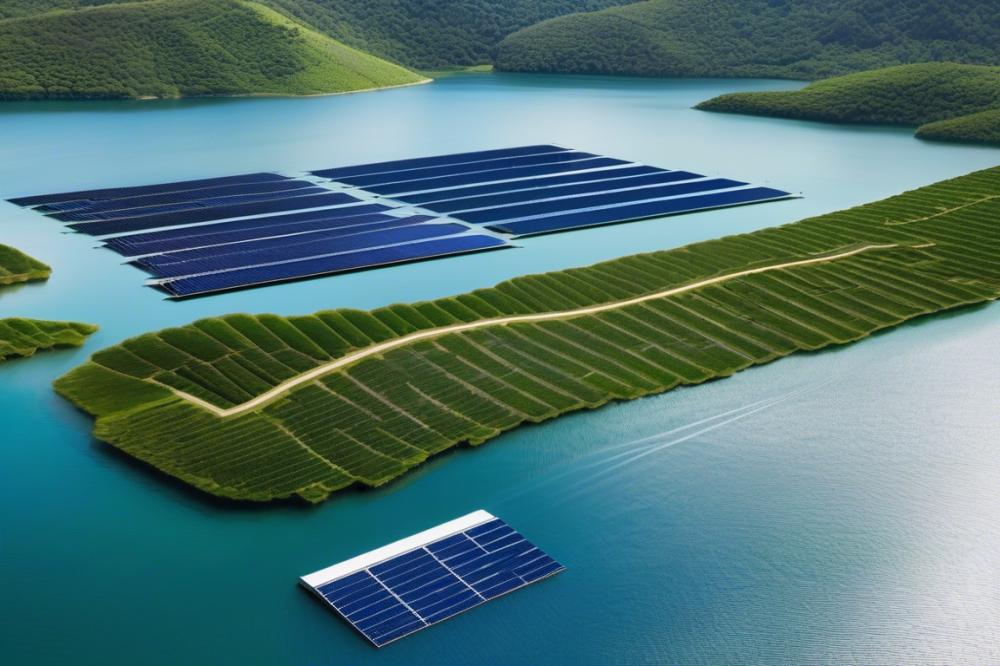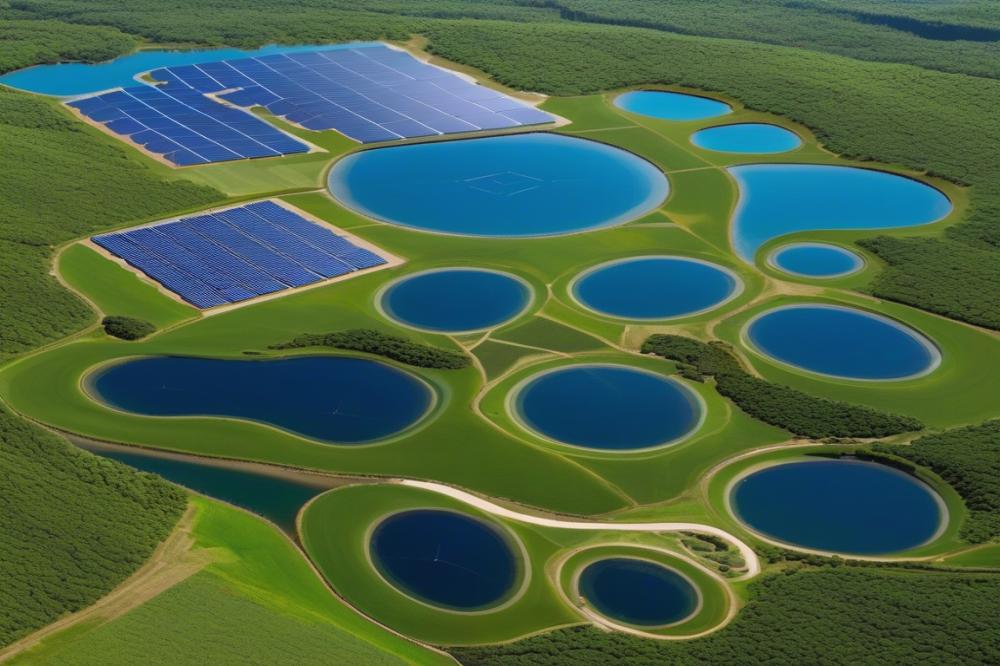Introduction
floating solar arrays are an innovative idea that captures sunlight while resting on bodies of water. This technology is changing how we think about solar energy and its potential uses. With the global push for renewable energy, these arrays offer impressive options for both home swimming pools and large-scale installations like the Longyangxia Reservoir.
The importance of renewable energy cannot be overstated. Modern society faces major challenges such as climate change and resource depletion. By utilizing solar energy, we can make significant strides toward a cleaner future. These advancements not only help the environment but also enhance energy efficiency in everyday life.
There are various potential applications for floating solar arrays. Homeowners can benefit by installing them on swimming pools, providing shade and reducing evaporation. This leads to improved water conservation. On a larger scale, global dams, like the Longyangxia Reservoir, can harness solar technology to generate considerable power while minimizing land use.
In essence, floating solar solutions represent a step toward sustainable development. They merge the need for energy with the responsibility of protecting our natural resources. With advantages in both environmental benefits and cost-effective solar solutions, it’s clear that the future holds exciting prospects for this growing field.
Understanding Floating Solar Arrays

Floating solar arrays are an innovative approach to harnessing solar energy. They consist of photovoltaic panels that are mounted on floating platforms. These structures sit atop bodies of water, such as home pools and large reservoirs.
How do they function? Electricity is generated when sunlight hits the solar panels. The panels convert sunlight into usable energy, thanks to photovoltaic technology. This energy can then power homes or feed into the grid, contributing to renewable energy efforts.
Comparing floating systems to traditional solar installations reveals some advantages. Ground-mounted solar panels require a lot of space, often taking up valuable land. In contrast, floating arrays utilize available water surfaces efficiently, allowing land to be used for agriculture or other purposes.
Environmental benefits are significant as well. Water helps keep the panels cooler, which can improve their energy efficiency. Additionally, the panels reduce evaporation from the water, promoting water conservation. Such dual action supports sustainable development in many regions.
The Longyangxia Reservoir in China showcases the potential for this technology on a large scale. Many experts believe that floating solar can offer solutions not just in urban areas but also in rural settings with large water bodies.
Overall, floating solar arrays represent a creative solution for maximizing solar energy production. This method not only addresses energy needs but also aligns with the goals of greener, more sustainable practices.
Floating Solar Arrays for home pools

Integrating solar panels over home pools offers numerous benefits. This innovation not only supplies renewable energy but also enhances energy efficiency. By utilizing space that would otherwise go unused, homeowners can maximize their resources while enjoying the aesthetics of a sunlit pool.
Benefits of Integrating Floating Solar Arrays in Home Pools
One major advantage of installing photovoltaic technology on pools is water conservation. These installations provide shade, which helps reduce water evaporation. This not only helps homeowners save money but also supports sustainable development goals by conserving precious water resources.
Environmental benefits of such systems are significant. They reduce carbon footprints by generating clean electricity and offsetting the need for fossil fuels. Utilizing floating solar solutions leads to decreased pollution levels, creating a healthier environment for everyone.
Cost-Effectiveness and Energy Efficiency
Cost-effective solutions are crucial for many homeowners. Floating solar panels lower electricity bills by generating on-site power. This immediate access to renewable energy is especially appealing in regions where traditional energy costs are high. Furthermore, the maintenance costs are often lower compared to ground-mounted panels, as they are less exposed to dirt and debris.
Energy efficiency is another advantage. With sunlight reflecting off the water, these systems often perform better than traditional roof installations. Increased energy generation leads to higher savings and better returns on investment, making solar an attractive option.
Case Studies and Examples of Successful Installations
Numerous successful installations can serve as inspiration. A home in California integrated floating arrays over its pool, cutting energy costs by 40%. Stories like this highlight the potential for such systems to transform private residences into energy producers.
On a larger scale, projects worldwide illustrate similar successes. The Longyangxia Reservoir, with its expansive floating solar array, stands as a testament to what renewable energy can accomplish. By combining innovative technology with vast water bodies, these projects are paving the way for a sustainable future.
Global Dams and Floating Solar Arrays
The importance of floating solar arrays has grown in recent years, particularly in global dam projects. These innovative systems use water surfaces to generate clean energy. This development is crucial for large reservoirs like the Longyangxia Reservoir in China. Here, the relationship between water bodies and renewable energy becomes clear. The potential for solar energy in such locations enhances energy efficiency significantly.
Longyangxia Reservoir stands as a prime example of this trend. It integrates photovoltaic technology on its surface, creating a unique synergy between water management and power generation. By utilizing the actual surface of the reservoir, it not only produces electricity but also helps in water conservation. When sunlight hits the panels, energy is produced without taking up valuable land. This feature makes it suitable for densely populated areas where space is a premium.
Environmental benefits arise from this model too. Floating solar systems reduce evaporation, which is vital in dry climates. This advantage is particularly relevant when considering global climate change and water scarcity. Furthermore, reducing the surface area of water exposed to sunlight helps lower water temperatures, which can positively impact local ecosystems.
Longyangxia also highlights another significant factor: energy production. By harnessing the power of the sun, this dam has become a beacon of sustainable development. Its installation contributes to the local grid, providing reliable electricity to nearby communities. The integration of this technology addresses a growing need for alternative energy sources in a world increasingly dependent on fossil fuels.
Floating solar arrays offer a versatile solution not just for large-scale projects like dams, but also for smaller applications, such as home pools. Homeowners can benefit from this renewable energy by using similar concepts. Therefore, the blend of technology, environmental care, and practical needs positions these solar systems as a forward-thinking solution in many contexts.
Renewable Energy and Sustainable Development
The role of floating solar arrays in promoting sustainable energy solutions
Floating solar arrays are becoming increasingly popular as a solution for renewable energy. These systems use photovoltaic technology to capture sunlight and convert it into electricity. For many homeowners, creating a sustainable setup for home pools becomes easier with this innovation. Utilizing space on water helps avoid land use conflicts. As cities grow, finding room for solar panels can be challenging.
This technology is not just limited to private pools. It also finds application in global dams like the Longyangxia Reservoir. Floating solar systems can contribute significantly to the overall energy mix. They can play a vital part in reducing greenhouse gas emissions. With each array installed, we move closer to a cleaner energy future.
Water conservation and reduced evaporation with floating systems
One important benefit of floating systems is their impact on water conservation. Water bodies often lose a lot of water through evaporation, especially in warm climates. By placing solar panels on the surface, we can reduce this loss. The panels create shaded areas that keep water cooler. This natural barrier can benefit not just pools but also large reservoirs. Dams like the Longyangxia Reservoir stand to gain from this approach.
Less evaporation means that more water remains available for other uses, such as irrigation or drinking. Every drop counts, especially in drought-prone areas. Utilizing renewable energy while saving water presents a dual advantage. It defines what sustainable development should strive for. Combining these strategies creates a more resilient infrastructure for future generations.
Future prospects for floating solar arrays in the renewable energy industry
Looking ahead, the future of floating solar arrays appears promising. Many experts believe this technology will see extensive growth in the renewable energy sector. As costs decrease and efficiency increases, adoption rates are likely to rise. This could lead to broader discussions about energy efficiency across various sectors.
Innovations in design and technology mean that these systems can adapt to different environments. Whether it’s a home pool or a massive reservoir, floating arrays can provide solutions. The versatility of this technology makes it uniquely positioned to address multiple challenges. Faster deployment and lower maintenance needs could also encourage wider acceptance.
Climate change demands urgent action. Float-mounted solar panels could be a game-changer in the race toward clean energy. Their environmental benefits go beyond just electricity generation. Future installations might integrate other features, such as water filtration systems or aquatic habitats. This creates an opportunity to enhance rather than detract from local ecosystems. The growing interest in marine and freshwater solar solutions may revolutionize how we think about energy and resource management.
Final Thoughts
Floating solar technology offers numerous advantages for energy generation. For homeowners, installing these systems on home pools can reduce electricity bills and harness the power of the sun without taking up valuable land. Meanwhile, global dams can integrate similar setups, minimizing evaporation from their surfaces while producing clean energy. This approach not only combats climate change but also conserves water resources.
Policymakers should prioritize incentives for renewable energy. Supporting floating solar projects can boost local economies and create jobs. Embracing this innovative method can lead to significant reductions in greenhouse gas emissions, which is crucial for a sustainable future. Every community stands to benefit from such initiatives.
The demand for clean energy sources continues to grow. Floating solar systems present a practical solution for both urban and rural settings. By making smart choices today, we can pave the way for an energy-efficient tomorrow. It’s time for homeowners and city officials alike to consider this viable option as part of their renewable energy strategies.
In summary, floating installations represent a promising step towards a greener world. They combine technology with environmental responsibility. Encouraging these practices can lead society toward a sustainable energy future that we all can enjoy.



